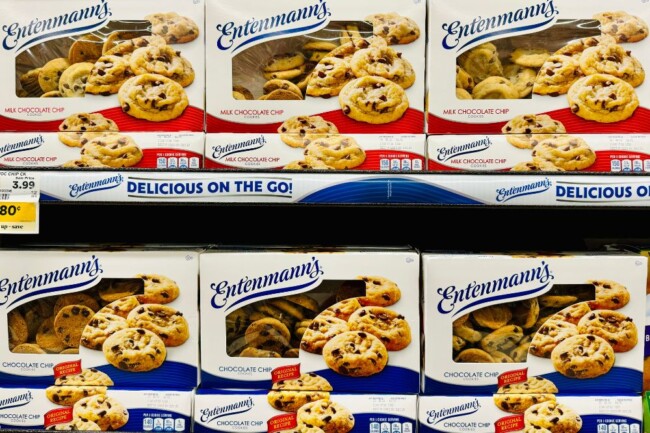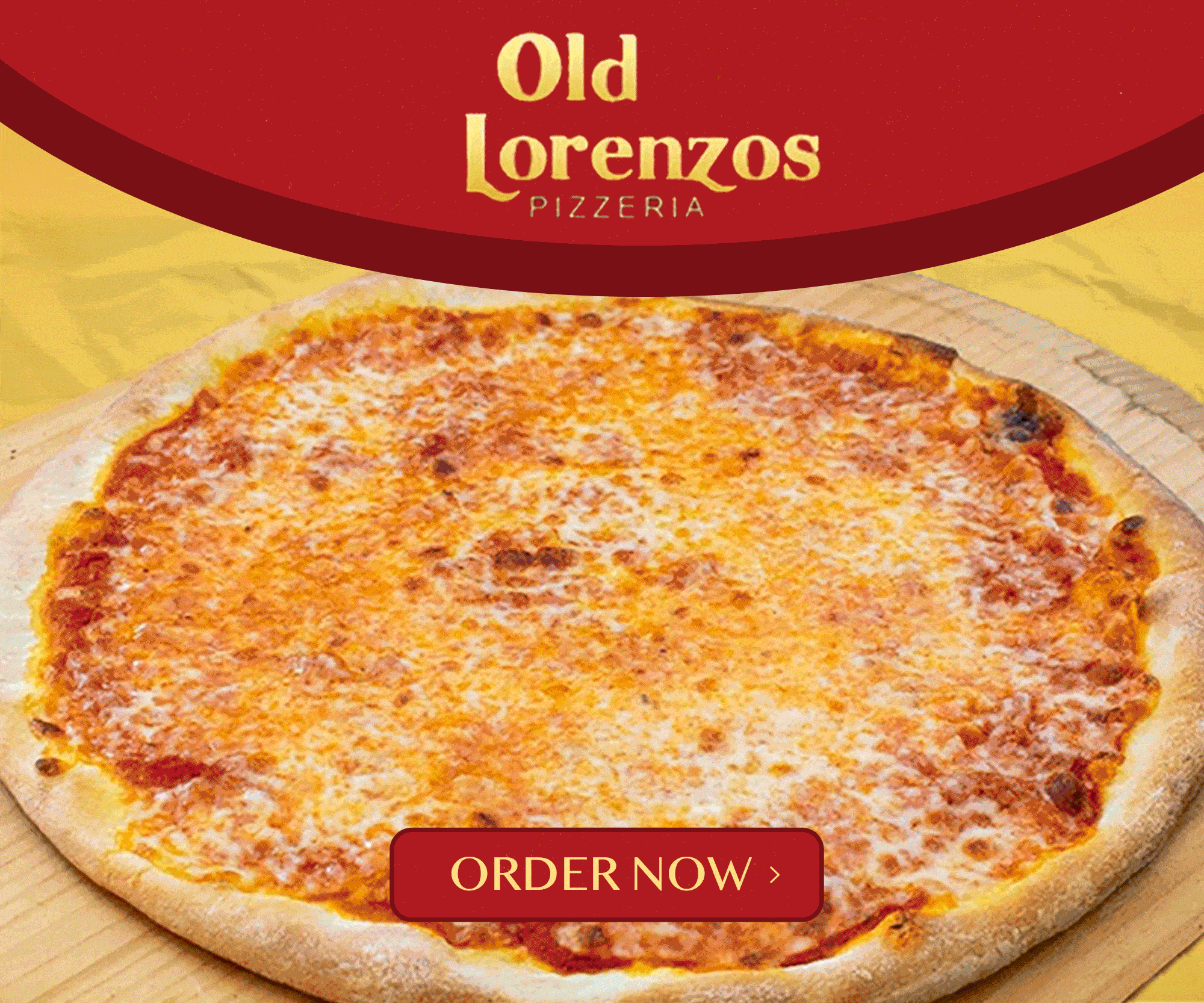Hoboken’s culinary heritage is often revered for its Mutz, but at one time, Hoboken was a veritable Willy Wonka factory brimming with assorted confections that could make Timothee Chalamet drool. To walk Hoboken was to smell the aromas of tea, coffee, cakes, breads, candies, cookies, and ice cream cones filling the air. To celebrate, The Hoboken Girl has rounded up Hoboken’s most famous foods for a mouthful of history. Read on to learn more about these food brands and their connections to the Mile Square.
Wonder Bread, Twinkies, Hostess, Oh My!
Wonder Bread, Twinkies, and Hostess have a long, interwoven history in Hoboken, but it all started with the Schmaltz Bakery which rose like dough in the oven to become Hoboken’s largest bread factory.
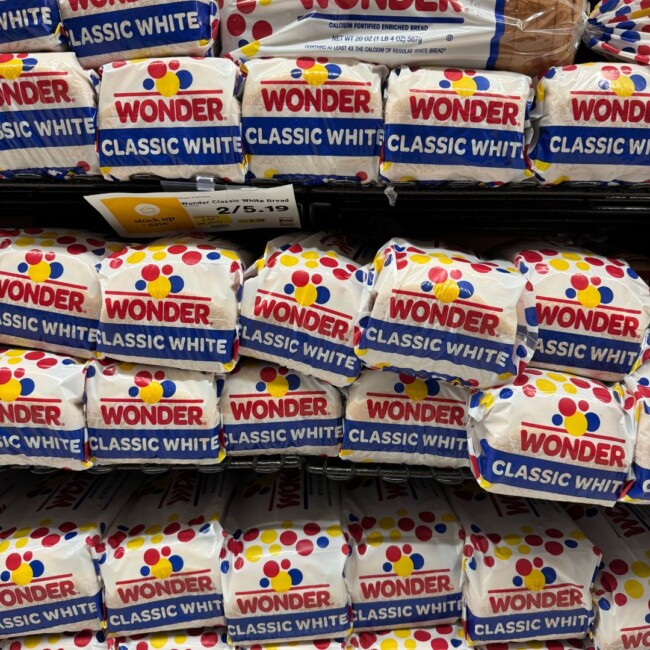
Founded in 1865 by a 25-year-old German immigrant, John Schmaltz + Sons delivered its famous Jersey Cream Malt Bread by horse and buggy from the Model Bakery, built at 720 Clinton Street. According to the Hoboken Historical Museum, the factory could produce 5,000 loaves in 10 hours. A fire reduced the original plant to ashes, but a new factory was erected in 1909.
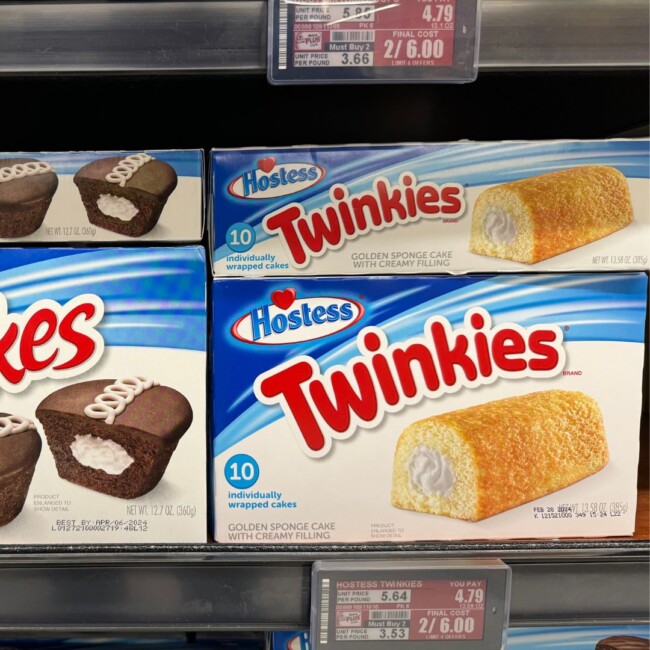
Over in New York, a string of acquisitions and mergers saw The Continental Baking Company become a juggernaut in America’s baking industry, producing household names such as Twinkie, Hostess, and Wonder Bread. Seeking to expand operations, the company needn’t look any further than across the river to Hoboken when it acquired John Schmaltz & Sons’ “Model Bakery” at 720 Clinton Street.
Now with a foothold in Hoboken, The Continental Baking Company sought to further develop factories within the town which was so conducive for manufacturing. The company built the Hostess Cake Kitchen on the corner of 14th Street and Park Avenue in uptown Hoboken.
For a time, Wonder Bread, Twinkies, and Hostess cupcakes were all baked in Hoboken and distributed around the country. The repurposed Hostess Factory continues to burn calories and sculpt buns, only now doing so as the New York Sports Club.
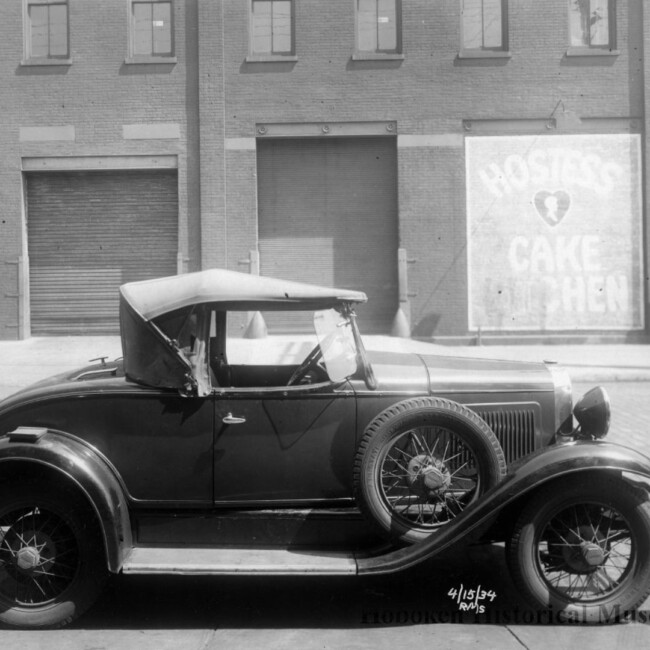
Photo Credit: Hoboken Historical Museum
Like the Lipton and Maxwell buildings, real estate developers recognized the opportunity to make a dollar while also retaining Hoboken history, and in 2022 Wonder Lofts revitalized the once-neglected factory at 720 Clinton Street. Today, a plaque located at the building’s entrance memorializes the history of what locals had once affectionately called The Wonder Bread Building.
Read More: The History of the Clam Broth House in Hoboken
Tootsie Roll: “Let Me See That Tootsie Roll!”
Salt Water Taffy famously originated in Atlantic City in the 1880s, but just as famous is the taffy confection, Tootsie Roll, which stuck around Hoboken like taffy to teeth. Tootsie Roll Industries was founded in Chicago in 1907, producing the first, individually wrapped “penny candy” in the United States.
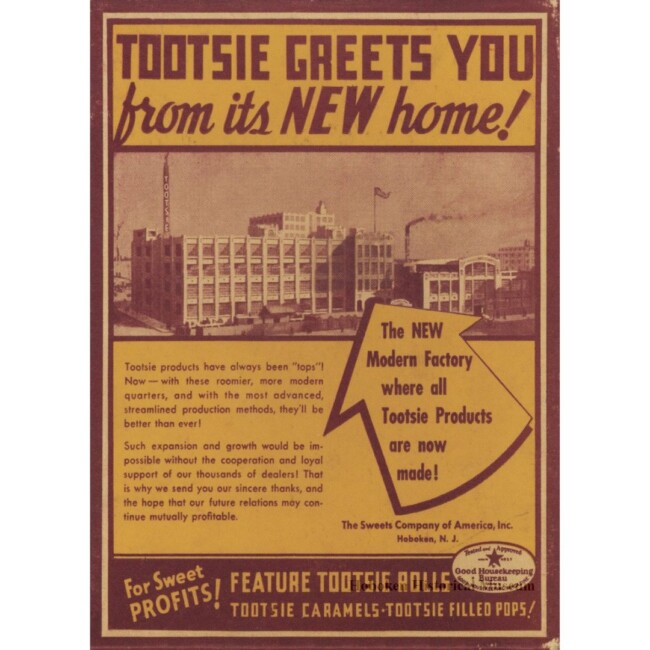
Photo Credit: Hoboken Historical Museum
In March of 1938, Tootsie, made by the Sweets Company of America, rolled its way into Hoboken with the factory occupying the entire square block at 1515 Willow, spanning from 15th to 16th Streets and Park to Willow Avenues. Candy seemed to explode out of the factory as workers tossed candy from the windows to eager children below. While Hoboken’s Tootsie Roll manufacturing ceased in the 1960s, the building retained a festive spirit by becoming the Macy’s Thanksgiving Day Parade Studio, housing all the Thanksgiving Day floats for the parade in Manhattan.
Ice Cream Cone: What if the Hokey-Pokey is What It’s All About?
When Italo Marcioni emigrated from Italy to the United States in 1895, he Americanized his name to Marchiony and could never have imagined that he’d revolutionize the way Americans enjoyed ice cream.
Settling in Hoboken, he worked in Manhattan as an ice cream vendor, thrusting his pushcart across Wall Street shouting “Ecco un poco!” — which translates from the Italian to “here’s a little!” and which is where the term “Hokey-Pokey” derives.
Unsatisfied with washing the sullied, often broken glasses where the ice cream was distributed, Italo developed an ingenious accessory. He would sell ice cream within a waffle cone — thereby saving him the cost of glass cups, and the time it took to wash and redistribute them. Filing his patent in 1902, by 1904 Italo distributed his revolutionary invention via horse-drawn wagon all across the NYC metropolitan area.
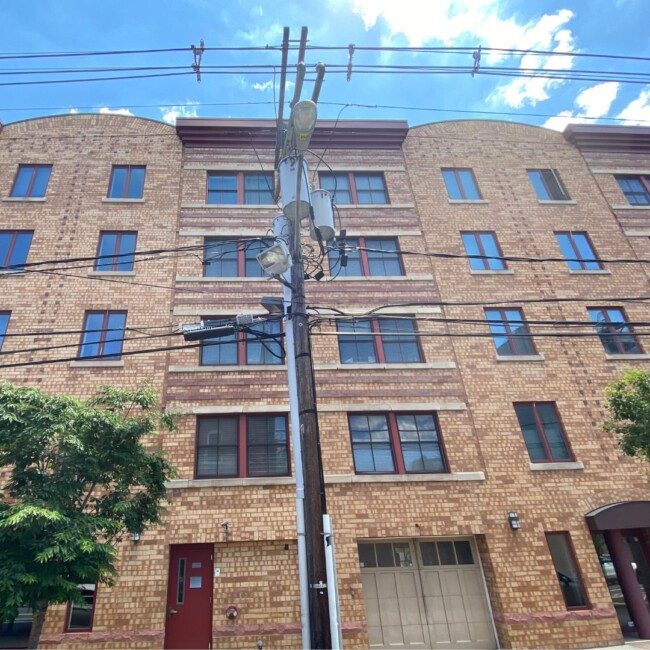
^ Former location of Ice Cream Cones
Also in 1904, Italo opened the Sun Light Plant at 223-225 Grand Street in Hoboken, where he manufactured his ice cream cones and wafers, becoming the first American manufacturer of Ice Cream Cones.
Maxwell House Coffee Plant: Good Until It Last Dropped
OG locals will tell you that the entire City of Hoboken once smelled of coffee, and for good reason. For nearly a half-century, the Maxwell House Coffee plant was Hoboken’s largest employer. In March of 1992, The New York Times proclaimed “The Smell of Roasted Coffee Comes to an End in Hoboken“. Lights went out on the iconic, neon sign with the trademark, upended coffee cup spilling Maxwell’s “good to the last drop” of coffee into the Hudson River.
Like many of Hoboken’s shuttered factories, real estate developers soon recognized what manufacturers had already known nearly a century before: that access to the Hudson River and an easy commute to New York City was profitable. Rather than warehouse goods within the NYC market, Maxwell Place could warehouse people, and the Toll Brothers redeveloped the site in 2008.
Lipton Tea: Steeped in History
Unsurprisingly, Lipton Tea began in the United Kingdom, founded by Scotsman, Sir Thomas Lipton in 1871. Nearly 30 years later, Thomas became the UK’s Titan of Tea, but sought to expand his empire to the United States. Thomas found the perfect location with ample waterfront for shipping, and close proximity to the large, East Coast cities. In 1916, Thomas constructed his warehouse and headquarters at 1500 Hudson Street with such a colossal sign, that it could be read across the river in NYC.
Despite being the largest worldwide trader of tea in the 20th century, the warehouse shuttered in 1963, when it moved headquarters to Englewood Cliffs with manufacturing plants scattered across the globe.
Like Hoboken itself, the Lipton Tea Warehouse was able to transform from a hub of manufacturing into a residential community. By April of 2000, The New York Times raved about the $75 million conversion into private apartments. In spilling some tea, the Hudson Tea buildings have also been home to some famous celebrities including two-time Super Bowl Champ, Eli Manning, and former Governor Jon Corzine.
Blimpie’s: Introducing America to the Sub Sandwich
It’s hard to believe, but at one time the submarine sandwich was considered an obscure ethnic food little-known to America. The Hero of this story is also called sub, hoagie…or hero, and was initially developed in Italian-American enclaves throughout the North East. How it became a nationally recognized staple of American cuisine starts on the Shore, in Point Pleasant. There, three classmates from Jersey City’s St. Peter’s Prep were enjoying the beach when they decided to grab a bite at Mike’s Submarines, which was founded in 1956 and would later become Jersey Mike’s Subs. The three friends were so enamored with the sandwich, they decided to open a store in Hoboken dedicated to the sub.
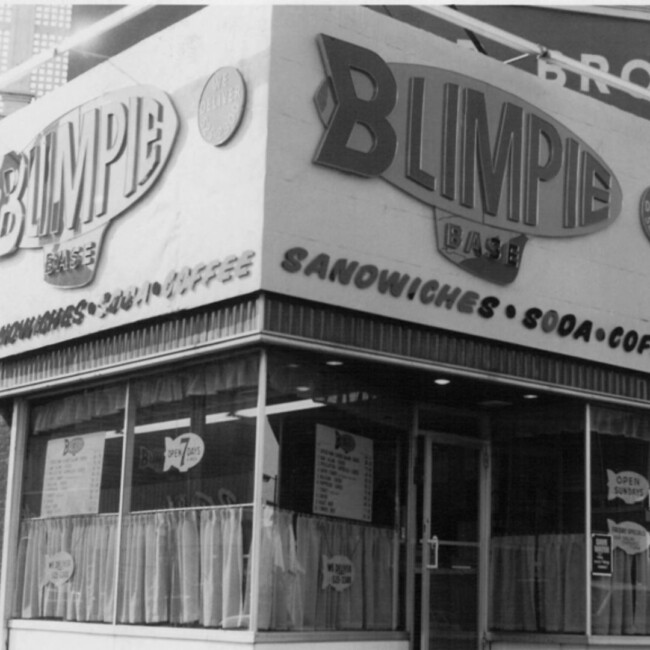
Photo Credit: Hoboken Historical Museum
On April 4th, 1964, they opened Blimpie at 644 Washington Street on the corner of 7th and Washington Streets. One year later, Subway was founded as “Pete’s Super Submarines” in Bridgeport, Connecticut. During the franchising process, Subway’s success eventually eclipsed Blimpie’s.
The Sub Saga was the subject of the History Channel’s The Food that Built America in an episode entitled “Submarine Warfare” — both in podcast form (5/18/24) and television (S3 E1).
Oreos: A Hoboken First
If you’ve ever strolled the waterfront, you’ll likely recognize the mural across from Sinatra Park with a surreal depiction of a woman sitting upon a large cookie. The woman upon the cookie portrays famed Hoboken photographer Dorothea Lange, while the cookie commemorates the world’s first Oreo ever enjoyed, here in Hoboken.
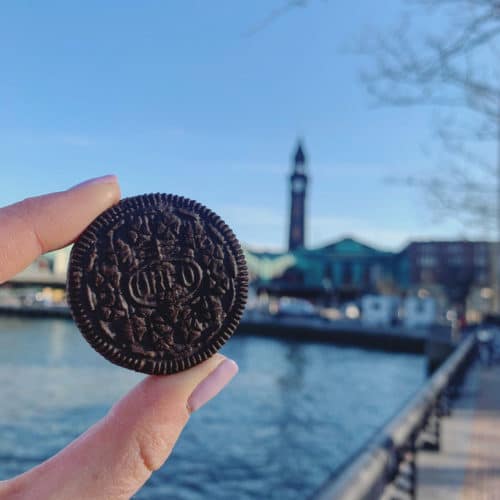
Though originally manufactured by Nabisco in Chelsea, Manhattan, the very first can of Oreos were snarfed down in Hoboken when S.C. Theusen sold the biscuits from his grocery store at 1026 Washington Street on March 6th, 1912.
Entenmann’s: One Smart Cookie
While local factories manufactured many world-renowned baked goods, one of the country’s most famous and influential bakers began as a bun in the oven in Hoboken. The matriarch of Entenmann’s baked goods was born under the name Martha Schneider at 124 Jefferson Street in Hoboken on November 26th, 1906.
Today the iconic white boxes embossed with a blue ribbon and the name Entenmann’s can be found in nearly every grocery store across America. Yet Martha’s early life was far from glamorous, moving around Hudson County as her father searched for meaningful employment.
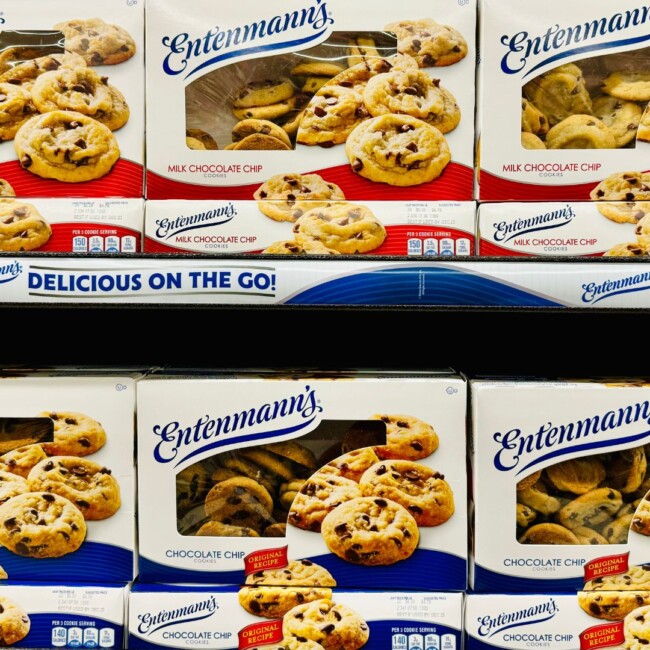
The youngest of four siblings, Martha grew up all across Hudson County, from 800 Bergenline Avenue (Union City) in 1910, to 131 Park Avenue and again at 1109 Willow Avenue by 1915 (in Hoboken). Come 1920, the family lived in Jersey City Heights as her father held down two jobs as a marine firefighter and baker — a profession which Martha would enter in 1925 at Bay Shore, Long Island. There, she found both employment and love when Martha married William Entenmann Jr., son of Entenmann’s founder, William Entenmann Sr. who’d established the brand in Brooklyn, in 1889.
Despite the Great Depression, Martha and William grew their family and business, delivering 3 boys and countless cakes across the tri-state area. When William died in 1951, Martha helped shift the company’s focus from home delivery to grocery store placement as she oversaw national expansion. Under Martha’s direction, products sold like hotcakes and in 1976 Martha sold the company to Warner-Lambert for $233 million — not bad for a Hoboken upstart’s startup.
Cake Boss: Having His Cake and Eating It Too
Martha Entenmann might have been the most famous baker from Hoboken, were it not for Buddy Valastro Jr. of Carlo’s Bake Shop, home of TLC’s Cake Boss.
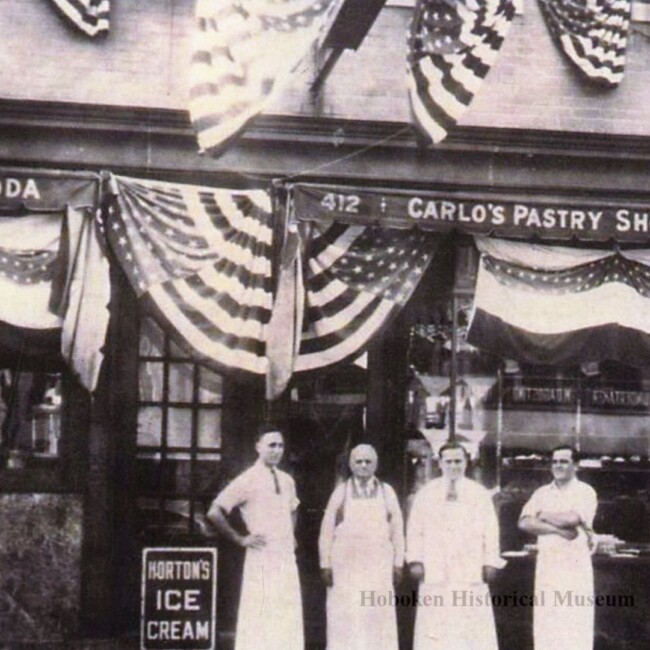
Photo Credit: Hoboken Historical Museum
Long before the limelight of syndicated cable television, Carlo’s Bake Shop served Italian pastries to hungry Hobokenites seeking a taste of their old-world home with new-world comfort. According to the Hoboken Historical Museum, Carlo’s was not founded in 1910 (as is advertised on current merchandise), but was founded in 1914, or possibly even 1916, by Carlo Guastaferro, with the original bakery located at 412 Adams Street. In 1964, Bartolo “Buddy” Valastro Sr. purchased the business where his son, Buddy Valastro (of TLC fame) developed his bread and butter.
In 1990, Carlo’s relocated to its current site at 95 Washington Street, across from City Hall. Yet it wasn’t until Buddy Valastro Jr. that the nation finally returned its attention to Hoboken as a baking Mecca.
Buddy competed in four of Food Network’s baking challenges before his wedding cakes won Battle of the Brides. Not satisfied with the $10,000 prize, Buddy pitched a reality show, which was picked up by TLC in 2009 and ran for an astonishing 11 years as Cake Boss, finishing in 2020. He’s since baked himself an assortment of spinoffs, such as Next Great Baker (2010), Kitchen Boss (2011), Buddy’s Bakery Rescue (2013), Bake You Rich (2013), Bakery Boss (2013), Buddy vs. Duff (2019), Buddy vs. Christmas (2020) Buddy Valastro’s Cake Dynasty (2023-present) and Legends of The Fork (2023-present).
Honorable Mentions Sprinkled Around Town:
Despite their resounding fame throughout much of the 20th century, as tastes changed, a variety of important and popular cooking products fell from the public eye.
Franklin Baker Company: The Coconut King
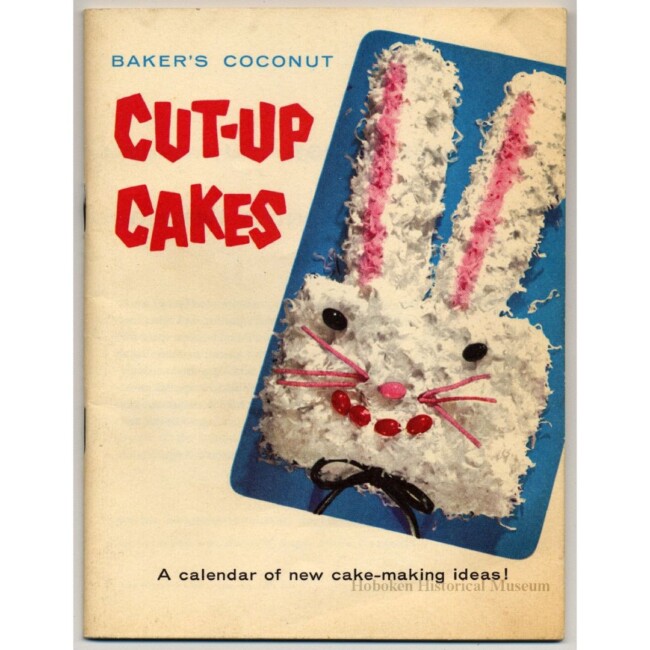
Photo Credit: Hoboken Historical Museum
In 1894, a Philadelphia miller, Franklin Baker, received a load of fresh coconuts from Cuba as payment for his exported flour. This quirky kerfuffle launched the largest supplier of coconut products in America. In 1924, the business relocated to Hoboken near 15th and Bloomfield Streets, where it remained until moving to Dover, Delaware in 1964.
See More: George Washington Once Dined at This Bloomfield Restaurant
RB. Davis Company: A Smorgasbord of Brand Names
R.B. Davis Company manufactured once-famous brands such as Davis OK Baking Powder, My-T-Fine Pudding, Swel Frosting Mixes, and Cocomalt — the last of which advertised on the wildly popular, nationally syndicated radio program “Buck Rogers.” Beginning around 1890-1, the Davis Company operated a factory on what is today’s Observer Highway and Jackson to Harrison Streets (today’s Chambord Place at 651 Observer Highway), operating until around 1970.

